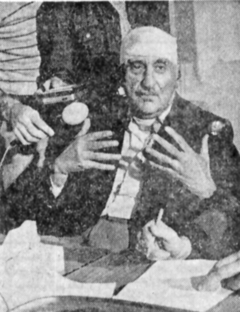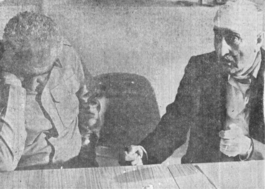Nematollah Nassiri
| General officer Nematollah Nassiri | |
|---|---|
.jpg) | |
| Born |
August 1911 Semnan, Qajar Iran |
| Died |
February 15, 1979 (aged 67) Refah School, Tehran, Iran |
| Allegiance |
|
| Service/ | Imperial Guard |
| Years of service | 1950s–1978 |
| Rank | General |
| Spouse(s) | Parvin Nasiri |
| Other work | Ambassador of Iran in Pakistan |
Nematollah Nassiri (August 1911 in Semnan – 15 February 1979)[1] was the director of SAVAK, the Iranian intelligence agency during the rule of Mohammad Reza Shah Pahlavi, and later the Ambassador of Iran in Pakistan. He was one of the 438 individuals who were arrested and executed in 1979 following the Iranian Revolution.[2]
Career activities
Nassiri served as the commander of the Iranian Imperial Guards during the Pahlavi dynasty.[3][4] He was arrested by the followers of Prime Minister Mohammad Mosaddegh when he delivered two decrees of the Shah to the prime minister.[3] A personal friend of the Shah, Nassiri participated in the 1953 Iranian coup d'état which removed Iranian prime minister Mosaddegh from power in 1953. He was appointed head of SAVAK following the failure of General Hassan Pakravan, the previous director, to prevent the assassination of Prime Minister Hassan-Ali Mansur on 21 January 1965. Nassiri was also made deputy prime minister.[5] He served in the post until 6 June 1978 when he was dismissed by the Shah.[6] Then Nassiri was appointed ambassador of Iran to Pakistan.[7]
Arrest and execution
With the constant development of the Iranian Revolution, the Shah ordered the Dissolution of SAVAK and Nassiri was called back from Pakistan[7] and was arrested together with 60 other former officials on 7 or 8 of November 1978[6] including high-ranking officials, such as former director of SAVAK Hassan Pakravan and former Prime Minister Amir-Abbas Hoveyda. When the Shah left Iran on 16 January 1979, Nassiri remained in prison until the fall of Shapour Bakhtiar's government on 11 February.
On 15 February, Nassiri was arrested by revolutionists and brought in the Refah School with other officials. He was tried in a Revolutionary Tribunal along 24 other individuals for a total of 10 hours and was charged -without any defence or concrete evidence of guilt- with corruption on earth, massacre of people, torture, and treason. He was sentenced to death and confiscation of property at 10 p.m. and after the sentence was confirmed by Ayatollah Khomeini, he was executed by firing squad at 11:45 p.m. on February 15th. [8]

References
- ↑ http://iichs.org/index.asp?id=637&doc_cat=1
- ↑ "Nematollah Nasiri: One Person's Story". Human Rights & Democracy for Iran. Retrieved 2018-09-15.
- 1 2 Rubin, Barry (1980). Paved with Good Intentions (PDF). New York: Penguin Books. p. 83.
- ↑ Welles Hengen (22 December 1953). "Mossadegh Gets 3-Year Jail Term". The New York Times. Tehran. Retrieved 24 August 2013.
- ↑ Rubin, Barry (1980). Paved with Good Intentions (PDF). New York: Penguin Books. p. 179.
- 1 2 Nikazmerad, Nicholas M. (1980). "A Chronological Survey of the Iranian Revolution". Iranian Studies. 13 (1/4): 327–368. doi:10.1080/00210868008701575. JSTOR 4310346.
- 1 2 Ward, Steven R. (2009). Immortal: A Military History of Iran and Its Armed Forces. Washington DC: Georgetown University Press. p. 214. – via Questia (subscription required)
- ↑ "Nematollah Nasiri: One Person's Story". Human Rights & Democracy for Iran. Retrieved 2018-09-15.

Further reading
| Wikimedia Commons has media related to Nematollah Nassiri. |
- Hoveyda, Fereydoun. The Fall of the Shah. Trans. Roger Liddell. New York: Wyndham Books, 1980.
- All Fall Down: America's Fateful Encounter with Iran ISBN 1-85043-009-8
